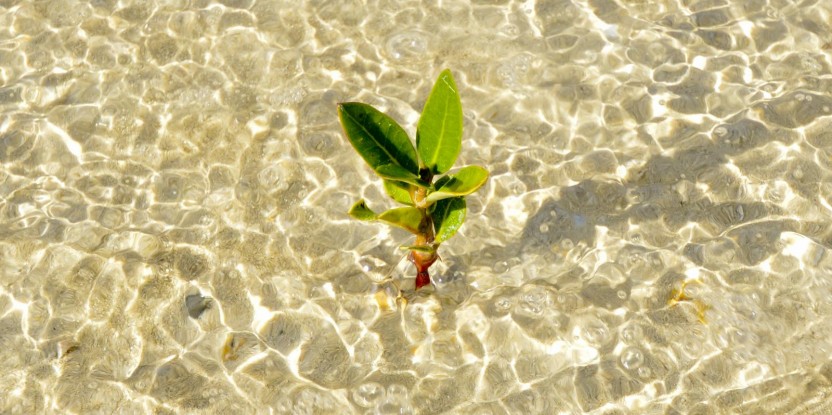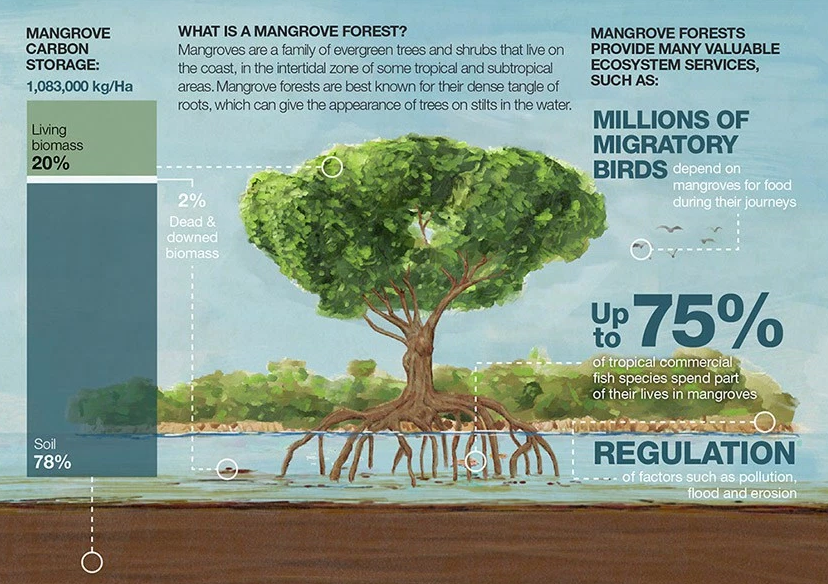Although mangroves will be able to withstand moderate sea level rise, the highest projections for the end of this century are likely to overwhelm many of these ecosystems, according to a new study.
“It’s a warning that this vital resource, which can actually help protect people against some of the impacts of climate change, is itself vulnerable to that change,” said lead author Sigit Sasmito, a researcher with the Center for International Forestry Research.
Mangroves have a built-in resiliency to fluctuating sea levels through what scientists call vertical ‘surface elevation change’. Researchers have been measuring this process in a handful of locations around the world.
But until this review of the existing literature, it was largely unknown how mangroves would fare against climate-induced sea level rise.
COMPARING VULNERABILITY
“We included two different types of mangroves in the study: fringe mangroves and basin mangroves,” said Sasmito.
“We were interested in which type might be more vulnerable, or if there would be any difference at all.”
Because of the uncertainties in projected sea level rise over the remainder of this century, Sasmito and his co-authors use both the low and the high sea level rise scenario from the most recent International Panel on Climate Change (IPCC) report (AR5).
Adaptation actions are not always very attractive, but in this case we can point to mangroves and say that protecting them is ‘mitigation-based adaptation’
The low scenario represents a sea level rise ranging from 28 cm to 61 cm by the year 2100, while the high scenario represents a rise of 53–98 cm.
“With high sea level rise, fringe mangroves are only likely to keep pace until 2055, and basin mangroves only until 2070,” said Sasmito.
“So we found that fringe mangroves are more vulnerable to sea level rise than basin mangroves.”
But not all the results are dire, and Sasmito suggests there are grounds for some cautious optimism.
The study found that under low sea level rise, both mangrove types are found to be able to cope at least until the end of the projection window in 2100.
“And that at least is encouraging,” said Sasmito.
ALREADY UNDER PRESSURE
Mangroves are in steady decline globally: more than half the world’s mangrove area was lost in the three decades leading up to 2007, according to the FAO.
Previous CIFOR research noted that Indonesia’s globally-significant mangrove areas were cleared at the staggering rate of 50,000 hectares per year between 1985 and 2000.
So, another factor in assessing how mangroves might cope with sea level rise is understanding their health status.
This is another major contribution of Sasmito’s study.
“By looking at mangroves facing different stresses, we also learn what types of management might be most conducive for helping mangroves cope with sea level rise,” said Daniel Murdiyarso, a principle scientist at CIFOR and a co-author of the study.
“It’s not just how mangroves cope with sea level rise, but also the way that interventions should be done to help them cope with it.”
Some mangroves in the study were in pristine condition, while others were recovering from stresses such as urban development and storm impacts, and some were being actively rehabilitated.
But Murdiyarso emphasizes that the conditions that favor mangroves’ ability to cope with sea level rise – and those that undermine that ability – need to be understood on a site-specific basis.
This will require more localized research, particularly in traditionally neglected areas, such as in Southeast Asia, Africa the Middle East and South America.
“Our study paints the backdrop against which more site-specific research can now be done,” said Murdiyarso.
‘MITIGATION-BASED ADAPTATION’
The evidence is mounting for the multi-faceted importance of mangroves, including but not limited to their carbon storage capacity, which is 3–5 times more than the same area of tropical forest.
The volumes of carbon stored in mangroves are especially large in Indonesia, which might make mangroves Indonesia’s best hope for contributing to slowing climate change.
Daniel Murdiyarso thinks it’s time to connect the two spheres that climate change policy and research is typically divided into: namely, adaptation and mitigation.
“There’s no point trying to do adaptation in isolation from mitigation. We should bundle the two together,” said Murdiyarso.
“Adaptation actions are not always very attractive, but in this case we can point to mangroves and say that protecting them is ‘mitigation-based adaptation’.
“It contributes to lessening the overarching problem – climate change – at the same time as helping to deal with some of the impacts that we already know are coming,” he said.
“In Paris COP21, a number of mitigation schemes, such as INDC, NAMA, REDD+ and Joint Mitigation Adaptation (JMA) were formulated as part of the Agreement,” said Murdiyarso. “These mecahanisms could potentially include carbon-rich reservoirs like mangrove ecosystems,” he further explained.
We want you to share Forests News content, which is licensed under Creative Commons Attribution-NonCommercial-ShareAlike 4.0 International (CC BY-NC-SA 4.0). This means you are free to redistribute our material for non-commercial purposes. All we ask is that you give Forests News appropriate credit and link to the original Forests News content, indicate if changes were made, and distribute your contributions under the same Creative Commons license. You must notify Forests News if you repost, reprint or reuse our materials by contacting forestsnews@cifor-icraf.org.


